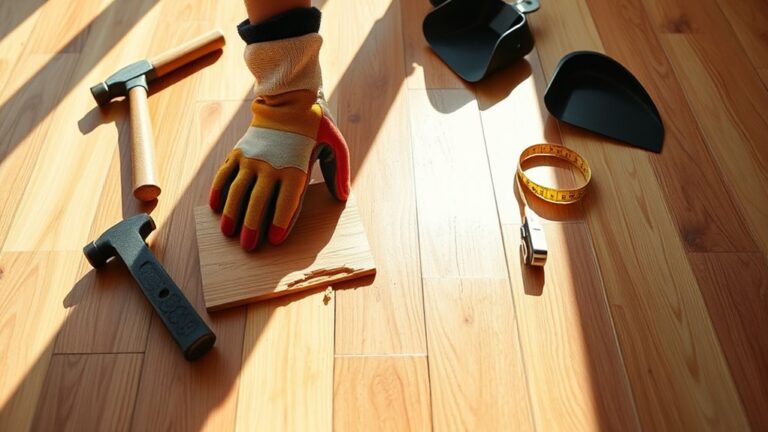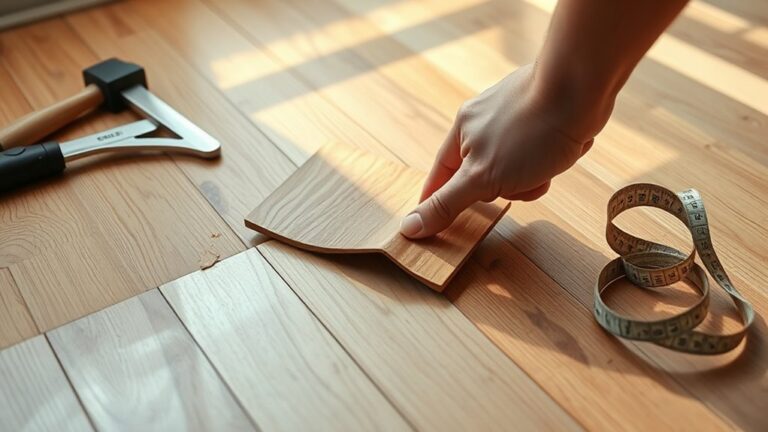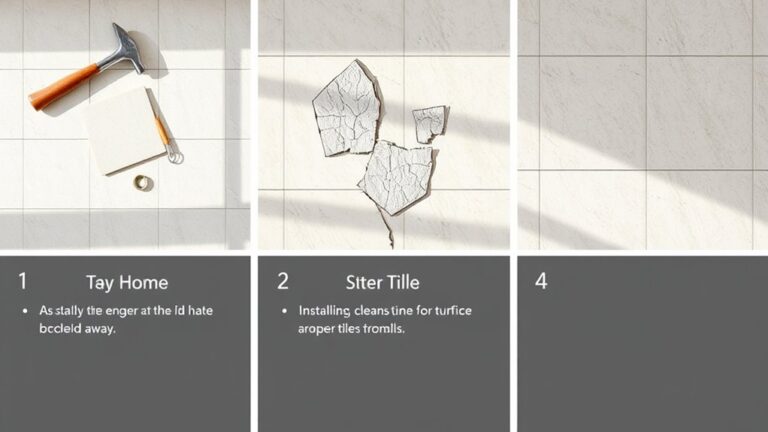To fix carpet buckling and ripples, first, identify their causes, like excess moisture or improper installation. Maintain indoor humidity around 50% to prevent dampness. For minor issues, you can use a knee kicker for re-stretching or apply carpet adhesive to loose sections. Professional re-stretching guarantees better results for severe cases, often costing between $40 to $80 per room. Regular vacuuming and rotating heavy furniture can help maintain your carpet's integrity. Understanding these methods leads to longer-lasting solutions, and there's more to explore for effective maintenance and repair techniques.
Understanding Carpet Buckling
Carpet buckling is a common issue that can affect any home, and it typically manifests as curled edges and uneven surfaces. This phenomenon can considerably detract from your carpet's appearance and functionality. The primary factors causing carpet to buckle include humidity, moisture penetration, and temperature fluctuations, particularly in four-season environments. High humidity levels can lead to excess moisture absorption in the carpet fibers, causing them to expand and buckle.
Improper installation techniques also play an important role in this problem. When carpets aren't stretched adequately or if incompatible underpads are used, the likelihood of buckling increases greatly. If the carpet is not secured properly during installation, it can shift and ripple over time, leading to unsightly distortions.
Additionally, heavy items dragged across the surface can exert stress on the fibers. This consistent pressure can result in rippling and eventually lead to buckling. Recognizing these causes early on is essential for maintaining your carpet's integrity.
Understanding the factors that contribute to carpet buckling enables you to take proactive measures to prevent it. By managing humidity levels in your home, ensuring proper installation, and being mindful of heavy items on the carpet, you can considerably reduce the risk of buckling. Remember, timely intervention can prevent further damage, allowing you to preserve the aesthetic and functional qualities of your carpet for years to come.
Common Causes of Buckling
Carpet buckling often stems from moisture and humidity issues, which can occur due to spills or high environmental humidity. Additionally, improper installation practices, such as inadequate stretching, can prevent the carpet from adhering correctly to the subfloor. Understanding these common causes is essential for addressing and preventing future buckling problems.
Moisture and Humidity Issues
Excess moisture retention, whether from spills, leaks, or high humidity levels, is a primary contributor to carpet buckling. When moisture infiltrates your carpet, it creates tension in the fibers, leading to unsightly ripples. In four-season climates, humidity fluctuations further exacerbate this issue, causing your carpet to expand and contract unevenly over time.
If moisture levels remain unchecked, you might face more severe problems like delamination, where the carpet's backing separates from the fibers. This separation not only worsens carpet buckling but also diminishes the overall durability of your flooring. To combat these risks, it's essential to implement effective moisture control measures. For instance, using moisture barriers in susceptible areas can greatly reduce the likelihood of trapped moisture.
Regularly monitoring indoor humidity levels is another key strategy. Ideally, you should maintain humidity around 50% to prevent conditions conducive to carpet buckling. By taking these proactive steps, you can safeguard your carpet's integrity and maintain a comfortable living environment. Remember, addressing moisture and humidity issues is vital for prolonging the life of your flooring and ensuring it remains visually appealing.
Improper Installation Practices
Moisture issues can often mask deeper problems related to installation practices. Improper installation practices, particularly inadequate stretching, are notable contributors to carpet buckling. If the carpet isn't stretched properly during installation, it can lead to loose areas that are more prone to wrinkling over time. Additionally, failing to secure carpets effectively to tack strips exacerbates this issue, allowing for movement that results in rippling.
Proper subfloor preparation is essential; if the subfloor isn't cleaned and leveled, it creates uneven surfaces that can cause buckling. Furthermore, using low-quality or incompatible padding during installation might not provide the necessary support for your carpet, increasing the likelihood of problems.
Inexperienced installers might neglect to allow carpets to acclimate to room conditions before installation. This oversight can lead to expansion and subsequent buckling once the carpet is laid down. By addressing these improper installation practices, you can greatly reduce the risk of carpet buckling and guarantee a longer-lasting, aesthetically pleasing floor. Taking the time to hire qualified professionals and confirming proper techniques are followed can make all the difference in the longevity of your carpet.
Signs of Carpet Rippling
If you notice noticeable ripples or waves on your carpet's surface, that's a clear sign of rippling. You might also find it difficult to move furniture or close doors over the carpet, indicating functional issues. Additionally, gaps between the carpet and baseboards can further highlight the presence of underlying ripples that need your attention.
Visual Indicators of Rippling
Carpet rippling can be easily identified by several key visual indicators that signal underlying issues. One of the most apparent signs is the noticeable ripples or waves on the carpet surface, which often appear as uneven areas scattered throughout your flooring. These uneven areas can disrupt the aesthetic and functional harmony of your space, making it essential to address them promptly.
Another significant visual indicator is the development of gaps between the carpet and baseboards or walls. This occurs due to carpet buckling, suggesting that the carpet has shifted from its original position. Pay attention if you find it increasingly difficult to move furniture or if doors struggle to close; these obstructions indicate that rippling issues are at play.
Additionally, you might observe increased wear and fraying at the edges of the carpet, particularly in areas where rippling occurs. This suggests that the carpet is experiencing stress and could lead to further damage if left unaddressed. Finally, small pockets of air may form beneath the carpet, which can be detected visually by pressing down on the surface to identify uneven rises.
Functional Impacts on Carpet
Rippling can severely affect the functionality of your carpet, leading to a range of practical challenges in your living space. When you notice noticeable ripples or waves on the surface, it's a clear sign of carpet buckles that can hinder daily activities. A wrinkled carpet can make it difficult to close doors or move furniture smoothly, as the uneven surfaces create obstacles. Additionally, gaps between the carpet and baseboards or walls often indicate that the carpet isn't adequately stretched, leading to further problems.
Increased wear and tear in areas where the carpet buckles can cause premature damage, necessitating costly repairs or replacements. You may also observe visible signs of damage or fraying at the edges, reinforcing the need for immediate intervention. Understanding the causes of carpet to wrinkle is vital for effective maintenance. Ignoring these signs can lead to a decline in both aesthetics and functionality, affecting your comfort and the overall appeal of your home. If you're experiencing these issues, it's important to address them promptly to restore your carpet's integrity and guarantee a safe, inviting environment.
Prevention Techniques
Proper installation is essential in preventing carpet buckling. When you hire experienced professionals who understand installation techniques, they'll guarantee your carpet is stretched adequately, reducing the risk of future issues. Here are some effective prevention techniques you can implement to avoid carpet buckling:
- Maintain indoor humidity levels around 50%.
- Use moisture barriers in high-humidity areas like basements or kitchens.
- Rotate heavy objects periodically to distribute weight evenly.
- Employ protective pads under furniture to minimize stress on carpet fibers.
- Allow wall-to-wall carpets to acclimate to the room's temperature and humidity before installation.
One of the main causes of carpet buckling is moisture in the environment. By keeping your indoor humidity in check, you can greatly reduce the risk of moisture-related issues. Additionally, using moisture barriers can protect your carpets from spills and high humidity, safeguarding them from excess moisture.
Heavy objects can also contribute to carpet buckling. By rotating furniture and using protective pads, you help distribute the weight more evenly, reducing pressure on the carpet fibers. Finally, letting your carpet acclimate to the room before installation guarantees it's better suited to handle the environment, further preventing buckling issues. By following these techniques, you can maintain the integrity of your carpets and enjoy a beautiful, smooth floor for years to come.
Effective Repair Methods
When it comes to fixing carpet buckling, you have several effective repair methods at your disposal. Professional re-stretching techniques are often the most reliable, but you might also consider DIY repair options or carpet adhesive solutions if you're looking for a more hands-on approach. Understanding the pros and cons of each method will help you make the best choice for your specific situation.
Professional Re-Stretching Techniques
To achieve a smooth, wrinkle-free carpet, professional re-stretching techniques are essential. This process typically involves experienced technicians using a power stretcher, which offers superior tension, especially in larger carpeted areas. They'll carefully grip the carpet, ensuring that any loose or buckled areas are pulled taut and secured to the tack strip, restoring the carpet's original appearance.
Here are some key aspects of professional re-stretching techniques:
- Power stretcher: Provides the necessary tension for large areas.
- Tack strip: Anchors the carpet securely, preventing future issues.
- Carpet adhesive: Used to enhance the durability of any loose sections.
- Minimized damage: Skilled technicians reduce the risk of harming the carpet.
- Cost-effective: Timely re-stretching can save you from more expensive repairs down the line.
Utilizing these professional methods not only enhances the aesthetic appeal of your carpet but also extends its lifespan. By addressing issues promptly, you can maintain an inviting and functional living space while avoiding the need for costly replacements.
DIY Repair Options
Carpet buckling can often be addressed effectively with DIY repair options, providing homeowners with a way to restore their carpets without professional help. A knee kicker is a fundamental tool for re-stretching your carpet back into place, guaranteeing it secures firmly to the tack strips underneath. For minor ripples, consider using a carpet rake to lift and smooth the affected areas. Follow this with gentle steam cleaning to relax the fibers without risking shrinkage.
If your carpet is considerably buckled, a power stretcher may be necessary to apply sufficient tension. However, exercise caution, as improper use can exacerbate the problem. For loose sections, applying carpet adhesive can temporarily secure the carpet to the subfloor until you implement a more permanent solution.
Before starting any repair, verify your carpet is completely dry. Wet carpets are susceptible to further buckling, complicating your efforts. By utilizing these DIY methods, you can effectively manage carpet buckling and maintain the integrity of your flooring, giving you the satisfaction of a job well done.
Carpet Adhesive Solutions
Using carpet adhesive can be an effective way to tackle loose areas of buckled or wrinkled carpets, restoring both their integrity and appearance. There are two primary types of carpet adhesives to evaluate: pressure-sensitive and permanent. Pressure-sensitive adhesives allow for easier adjustments, making them a preferred choice for many DIY enthusiasts.
Before applying the adhesive, verify you thoroughly clean the affected area. This step is vital for proper bonding and to prevent further damage. Follow these guidelines for the best results:
- Choose the right type of carpet adhesive for your needs.
- Apply adhesive in a well-ventilated area to minimize fumes.
- Use a roller or brush to evenly distribute the adhesive.
- Allow the adhesive to set according to manufacturer instructions.
- Assess the need for professional re-stretching if minor buckles persist.
While carpet adhesive can effectively address minor wrinkling or buckling, keep in mind that more significant issues may require professional re-stretching to achieve a completely smooth finish. By following these steps, you'll enhance the durability and appearance of your carpet, providing a fresh look to your space.
Professional vs. DIY Solutions
When it comes to addressing carpet buckling, homeowners often face a choice between professional services and DIY solutions. Professional solutions typically involve re-stretching your carpet with specialized tools like power stretchers. These tools guarantee proper tension, leading to long-lasting results that effectively eliminate wrinkles. Hiring a professional usually costs between $40 and $80 per room, but the investment often pays off with a warranty on your carpet, giving you peace of mind about its durability.
On the other hand, DIY methods can seem appealing. You might consider using a knee kicker for smaller areas. However, this approach often lacks the effectiveness and precision of professional equipment. While it may work temporarily, it might not address the root cause of your carpet buckling, potentially leading to further complications and additional expenses down the line.
For larger or heavily trafficked areas, professional assistance is generally recommended. The expertise of a trained technician can make a significant difference in the outcome, guaranteeing that the carpet is not only re-stretched but also positioned correctly to prevent future issues. If you're aiming for a durable, wrinkle-free carpet, weighing your options carefully is essential. The freedom to choose between professional and DIY solutions is yours, but understanding the benefits and limitations of each will guide you toward the best decision for your home.
Costs of Re-Stretching
Understanding the costs associated with re-stretching is crucial for homeowners facing carpet buckling issues. The average cost for re-stretching a room typically ranges from $40 to $80, depending on the extent of the buckling. If your buckled carpet is greatly affected, be prepared for total re-stretching costs that can reach up to $350 for a single room. Newer carpets, usually less than a year old, tend to incur lower re-stretching costs due to less wear and tear.
When considering re-stretching, it's important to factor in potential additional expenses. Here are some points to keep in mind:
- Moving furniture: This may require extra labor and could increase your costs.
- Opening seams: Repairing or re-opening seams can also add to the overall pricing.
- Discounts: Some retailers may offer discounted re-stretching rates for returning customers, which can save you money.
- Combination services: If you plan to request a re-stretch alongside carpet cleaning services, inquire about package deals.
- Extent of damage: The severity of the buckling directly affects the price, so a thorough assessment is crucial.
Long-term Maintenance Tips
Maintaining your carpet's integrity is essential to preventing issues like buckling and extending its lifespan. Regular vacuuming is a vital first step; it helps remove dirt and debris that can wear down your carpet fibers and contribute to potential buckling. Aim to vacuum at least once a week, ensuring your carpet remains clean and resilient.
Humidity plays a significant role in carpet maintenance. Keeping indoor humidity levels around 50% can prevent moisture-related problems that lead to carpet buckling. A dehumidifier can be beneficial in damp climates, while humidifiers can help in dry conditions.
Choosing high-quality carpet padding during installation provides the necessary support to your carpet, reducing the risk of buckling and enhancing its durability. This foundational layer absorbs impact and helps maintain the carpet's shape over time.
It's also wise to rotate heavy furniture periodically. This practice distributes weight evenly, minimizing stress on specific areas and preventing permanent indentations or buckles. Avoid dragging heavy objects across the carpet; instead, lift them to reduce wear.
Lastly, educate yourself on proper carpet care techniques. Allow your carpets to acclimate before use and be mindful of the environmental factors that could affect their longevity. By following these long-term maintenance tips, you'll not only preserve your carpet's appearance but also enjoy a more comfortable and inviting living space.
Choosing Quality Carpets
How do you guarantee your carpet investment pays off in the long run? The key lies in choosing quality carpets that are designed to withstand the test of time. When you're shopping for carpets, focus on materials known for their durability, like nylon or polyester. These fibers resist wear and tear, assuring your carpet remains in good shape longer.
Consider the following factors when selecting your carpet:
- Fiber Density: Higher density fibers offer better support and longevity.
- Premium Carpet Padding: Investing in quality padding enhances comfort and stability, helping to prevent issues like buckling.
- Moisture Resistance: Look for carpets treated for moisture resistance to protect against humidity-related problems.
- Manufacturer Warranties: Research warranties to assure your carpet maintains its shape and appearance.
- Reputable Brands: Choose brands known for their commitment to quality.
Customer Experiences and Feedback
Investing in quality carpets is just the beginning of guaranteeing their longevity; customer experiences emphasize the importance of regular maintenance and professional services. Many clients report that utilizing professional carpet cleaning and re-stretching services greatly improves the appearance of their carpets, often making them look almost new again. When you encounter carpet buckling, re-stretching your carpet is an effective solution that not only enhances the aesthetic appeal but also promotes tenant satisfaction in rental properties.
Customers frequently commend the thoroughness and attention to detail displayed by service providers during the carpet repair process. This level of professionalism guarantees that issues are addressed thoroughly, preventing future problems and costly repairs. Property managers have noted that effective carpet re-stretching considerably reduces buckling, thereby enhancing overall property aesthetics and fostering a better living environment for tenants.
Moreover, positive feedback often highlights exceptional customer service. Clients appreciate flexible scheduling options and the responsiveness of service providers to inquiries about carpet maintenance. Such attention to customer service not only builds trust but also encourages ongoing relationships, allowing you to maintain your carpets in prime condition.
Investing in professional services for carpet care isn't just an expense; it's a strategic decision that leads to long-term savings. By preventing severe damage through regular maintenance, you guarantee that your carpets remain an asset rather than a liability. Embrace the freedom that comes from knowing your carpets are well cared for, and enjoy the benefits of enhanced aesthetics and tenant satisfaction.
Frequently Asked Questions
How to Restretch Carpet Yourself?
If you're looking to give your carpet a little TLC, consider using some handy carpet tools and stretching techniques. With DIY methods, start by clearing the area and cutting the carpet from the tack strip. Avoid common mistakes by ensuring it's pulled tight against the walls. Use a knee kicker to distribute tension evenly, and remember maintenance tips like regular vacuuming to keep it looking fresh. You'll have that carpet lying flat in no time!
How Do You Flatten Wavy Carpet?
To flatten wavy carpet, you can use various DIY carpet solutions. Start by identifying the wavy areas and employ carpet care techniques like re-stretching with a power stretcher or knee kicker for effective tension. For temporary fixes, heavy furniture can help smooth minor waves. Remember, maintaining consistent humidity levels is essential for carpet maintenance. If you're facing persistent issues, consider professional flooring repair methods to guarantee long-lasting results in your home improvement projects.
How Do You Flatten a Buckled Rug?
When it comes to flattening a buckled rug, you'll want to tackle it like a pro. For effective rug maintenance, consider using carpet cleaning techniques like steam cleaning to add moisture, which encourages fibers to relax. You can also weigh down the affected areas with heavy furniture. Remember, proper flooring installation advice includes ensuring you have adequate padding underneath for moisture control. These home decor ideas can help keep your rug looking its best.
How Do You Get Ripples Out of Carpet Without a Stretcher?
To get ripples out of carpet without a stretcher, start with some effective carpet maintenance tips. You can try DIY carpet repair techniques like vacuuming the area to lift fibers. Using a hairdryer on low heat can relax the fibers, while a damp towel and an iron can help smooth out wrinkles. If those don't work, carefully pull the edges and re-tuck them. Remember, these methods address common carpet issues without specialized flooring tools.




